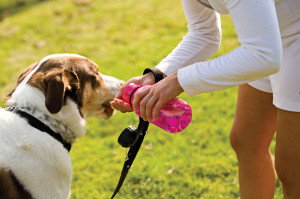Posts Tagged ‘summer heat and pets’
How To Prevent Heatstroke With Your Pet
 With the dog days of summer upon us, we as pet owners need to be aware of heatstroke with your pet. This can be a life-threatening condition that occurs because your pet cannot lower its body temperature efficiently, so its body temperature increases to dangerous levels.
With the dog days of summer upon us, we as pet owners need to be aware of heatstroke with your pet. This can be a life-threatening condition that occurs because your pet cannot lower its body temperature efficiently, so its body temperature increases to dangerous levels.
There are many common situations that can set the stage for heatstroke. These include: strenuous exercise in hot, humid weather, being a brachycephalic (short-nosed) breed, suffering from heart or lung disease that interferes with efficient breathing, being confined without shade or shelter and fresh water in hot weather, being confined on concrete or asphalt and the most logical-left in a closed up car in the warm weather.
Heatstroke begins with heavy panting and difficulty breathing. The tongue and mucous membranes appear bright red. The saliva is thick and tenacious and the dog usually vomits. The rectal temperature rises to 104 to 110 degrees Fahrenheit. The dog becomes progressively unsteady and passes bloody diarrhea. As shock sits in, the lips and mucous membranes turn gray. Collapse, seizures, coma and death rapidly ensue.
It is important to take emergency measures to begin cooling your pet immediately. One suggestion would be to move it to an air-conditioned building and begin cooling your pet with spraying your pet with a garden hose or immersing it in cool water for up to two minutes. Also if possible, it is helpful to place the wet pet in front of an electric fan. Ice packs work well when applied to the groin and armpit areas because this is the area where the blood is the closest to the surface in the body. Monitor the rectal temperature and continue the cooling process until it falls to 103 degrees. Seeking veterinary assistance is of utmost importance since this is an emergency. Your veterinarian will take steps to reverse the effects of heat, dehydration, and low blood pressure. An IV catheter will be placed and fluids will be given to help get blood flowing to major organs again.
Treatment is aimed to supporting these organs in the hope that the damage that they have sustained isn’t permanent. Unfortunately, it will often take days to know which organs have been affected. Specific treatments may include antibiotics, blood pressure medications and blood transfusions.
Because heatstroke can be so deadly and strike rapidly, it is best to take steps to prevent it. In hot weather, it is best to exercise your pet during the coolest part of the day (early morning and late evening) and always provide plenty of fresh, cool water and rest. A person can also help their pet by cooling them by allowing them to swim or spray them off with a hose after exercising.
Never leave a pet in a car during warm weather-not even for a few minutes with the windows cracked. Brachycephalic dog owners should be extra vigilant, keeping their dogs inside in air-conditioning on hot days. All geriatric, obese, and respiratory compromised pets should be exercised with caution in hot weather.
So remember if your pet is acting distressed, start cooling it down and seek assistance from your veterinarian immediately.
